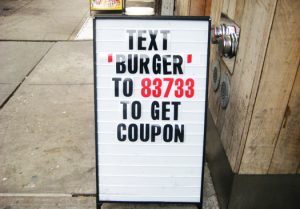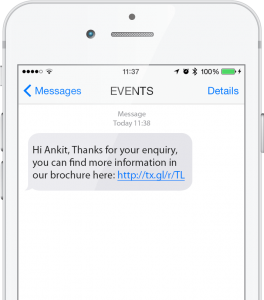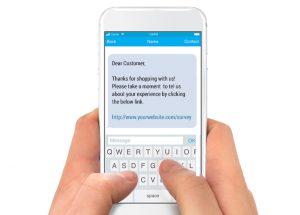Know The Secrets Behind How To Increase Readership
In this mobile-first age where TV ads are skipped and email inboxes automatically filter out promotions, it’s not surprising that marketers are desperate for a tool that can reliably get user’s attention.
What is surprising though, is how influential the lowly SMS text message, a tool that was invented during the early ‘90s, has remained.
Yes, people, we are talking about a 25-year-old tool that is still effective so much so that it boasts an open rate like none other – 98%.
To accelerate services across any and all industries, increasing the number of customer touch points is a good start, but when it comes to content, most marketers only have eyes on internet and digitalization.
Agreed, digital channels are the most correct medium to promote content but there are other communication mediums that would be an effective addition to the digital channels and SMS tops the list.
Not many people are readers, but with the right content and the right medium of communication in business, you can even turn a non-reader to a reader. What it requires is their type of content and a simple way of communicating it. And, what can be simpler than an SMS.
- SMS is the basic functionality that comes with every mobile phone irrespective of its features or price range and an incoming SMS is accepted and read by all.
- A humane and high-engagement channel, SMS provides an opportunity to connect with a large number of potential and current readers, without adding much burden on your marketing budget.
Let us now look at how you can increase readership of your content using text messages; a humble medium of communication in business.
-
It’s All About The Right Timing
It takes people an average of 3 minutes to open an SMS. Clients’ responses to sales, promotions, and events promoted on SMS are most effective when they’re last-minute impulses.
In their text message campaign, a Dallas lifestyle magazine, sent a short message to each reader at noon, the day before a new edition would hit newsstands. The message was intended to reach the reader when they might be taking a break and would be surfing their phone for social media postings and internet news to read. The timing of the message worked wonderfully as nearly 20% of those that received the message viewed more than three pages on the site.
To optimize marketing results, you can take SMS timing one step further by finding out the best time to send a message to a specific individual based on their past interactions with your texts.
-
Increase Customer Engagement – Call-To-Action
Calls-to-action increases customer engagement and that’s exactly what you want: for the audience to read, interact, and ultimately act on the SMS.

A keyword and a short-code/long-code number can be two factors to drive a successful SMS campaign. If you want customers to take part in a campaign that has them text your keyword to your code make sure those two items stand out. Bv
-
Create A Teaser Campaign
Use SMS to compliment your teaser campaigns where you can send out a preview of what is to come –
- The gist of the post
- The headline
- A few pointers
- The context
Containing it in a single SMS would be restricting but not with a shortened URL that increases the anticipation of what’s yet to come.
-
Create A Sense Of Immediacy

Including some sort of expiration date encourages customers to respond faster, helping you achieve results or gain information as quickly as possible. With your content, it can be linked to the first few hundred downloads/reads/buy that get an extra insight or some other gratification.
-
Run Targeted Promotions
If your priority is to drive clicks and sales, targeting readers who’ve already expressed interest in the author/publishers and are specifically looking out for their new articles to enjoy can drive better engagement. Ad platforms allow authors and publishers to reach potential and existing readers.
If your priority is to drive comments and likes, sites like Facebook and Twitter let you target ads to a fine-tuned audience based on preferences users have expressed on those platforms.
-
Personalize The Texts

Customers respond more to material addressed directly to them, so wherever you can, insert your subscribers’ name. Also, target your existing customers with more relevant texts based on their readership preferences.
-
Promote Opt-In Across All Media
The best way to engage customers with content to increase readership is to give them the chance to opt-in at every point of contact.
- Social Media
- Website
- Newsletter
- Point-of-sale
- Snail mail
- SMS
-
Create A Reader Community – Closed – Two-Factor Authentication Solution
Giving readers a dedicated community space can help them feel more connected to a writer/blogger/publisher. While these communities might only have a few dozen or a few thousand fans, but those who participate often become loyal advocates for the author. Many authors and publishers use Facebook groups to house these communities and you can keep it a closed group by setting up a two-factor authentication solution.
The two-factor authentication solution via SendOTP can help authenticate users through a one-time password and allow the author to interact with the chosen audience in a closed group setting.
-
Use Feedbacks/Surveys/Webinar To Make Interaction More Personal

To grab a reader’s attention is comparatively easy; retaining it is what is difficult. Use text messaging services to send them feedback links or surveys or the webinar link via SMS where readers could share their opinions or interact through a Q&A session.
The Secrets Are Out
Short by their very nature, that doesn’t mean text messages can’t be effective in communicating vital information or driving traffic to longer forms of media like websites, blogs, or videos. Text messaging services allow companies, brands, organizations, writers to engage customers and users in a way that gets their attention and encourages them to explore larger sets of information like articles, news, and features.
Having loyal readers can make it easier for a writer/brand to increase readership. While reader loyalty is primarily fostered from the love of the brand/writer/previous content, it can also be cultivated through user engagement.
- A campaign based on analytics
- Time it right
- Target your audience
- Add personalization
- Clear CTA
- Add a sense of immediacy
- Across all mediums
- Use for feedback/survey
Getting readers to engage online takes time and effort, which may not yield immediate revenue, and the ROI of these efforts can be difficult to measure, but with the right medium of communication in business, anything is possible.
SMS Usecase – How webzines increased their readership with text messaging service.
- To distribute news, features and columns, The New York Times occasionally offers a text messaging service that allows readers to connect with Times reporters and features. It also allows readers to text and chooses their favourite sections to receive the latest news or their favourite columnists.
- USA Today sends targeted ads via text messages that readers can request on their cell phones, in addition to updated information on sports, stocks, weather and other news.
- To better reach their target affluent 25 – 45-year-old readers, Philadelphia Style Magazine Philly Style offered the first 50 text subscribers a gift certificate for a free appetizer and cocktail at the restaurant of their choice. They reinforced the campaign launch in the subscriber email newsletter.
| | | --- | | Text STYLE to CLUBS (25827) and receive alerts for special STYLE events and exclusive sweepstakes! |
As publishers migrate toward digital products and services, text messaging is fast becoming a part of the mix. Let’s get you started right away.
Views: 114
- marketing-communication
Copyright 2008-2025, Superheroes, Inc. | All rights reserved.